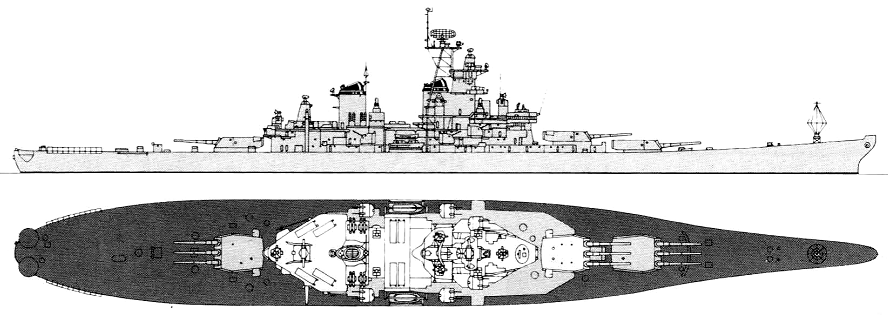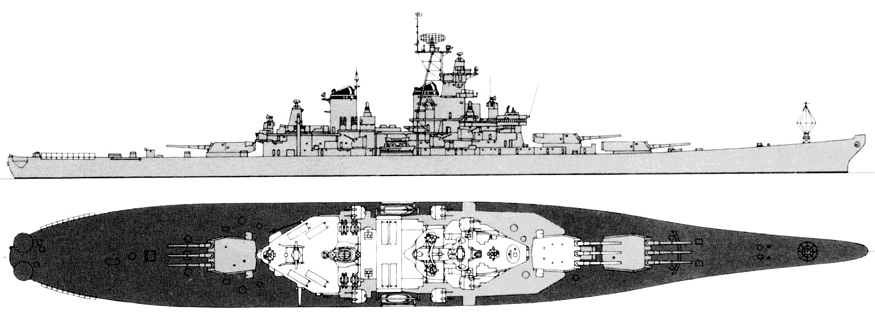- Yes
- No
History.
In 1937, the US Bureau of Construction and Repair began developing a new class of battleships for the US Navy, driven by rising international tensions and the need to replace obsolete battleships. The main objective in designing the South Dakota class was to increase protection without sacrificing armament or speed compared to the North Carolina class. This was achieved by reducing the length of the hull and making changes to the armour, narrowly meeting the 35,000 ton limit.
Meanwhile, Japan’s reluctance to comply with naval treaties convinced the signatories of the Second London Naval Treaty to raise the displacement limit for capital ships to 45,000 tonnes in June 1938. However, already in 1935 the United States had started work on a battleship with a higher displacement. For the design of the next class of battleships, it was therefore decided to further increase the displacement by 10,000 tonnes. Special attention was paid to speed, so that the new ships could operate alongside aircraft carriers. The armour scheme remained similar to that of the South Dakota class, while the main armament was considerably improved.
The first two ships of what was to become the Iowa class were authorised on 17 May 1938. These ships were assigned hull numbers BB-61 and BB-62 and the names Iowa and New Jersey, respectively. Two more battleships were authorised on 6 June 1939. All four ships had a very long and successful service career. Two more ships were ordered on 19 July 1940 but their construction was halted due to the end of World War II.
The first ship of this class, named “Iowa” after the 29th US state, participated in the Allied Pacific campaign from 1943 to 1945, also carrying President Roosevelt, and after the end of the war was brought back home for some armament work and testing. With the outbreak of the Korean War, the ship was returned to action and participated in bombing missions against communist forces until the end of the conflict.In 1958, after joint exercises with other NATO naval forces, the ship was decommissioned and sent back to US ports.
In 1982, the administration of the new President Ronald Reagan decided to refit the ship and work began almost immediately with the removal of several of the oldest and most outdated weapons on board and their replacement with more modern systems. Within a year, the firing control and radar search systems were also modernised, and to shorten the work some weapons tests were avoided. After the works, the ship took part in various NATO and non-NATO exercises, and was made to participate in the first Gulf War as it did during the Korean War. In 1989, the ship had a terrible accident during a firing exercise (for causes still partly unknown) to one of its main turrets causing the loss of 47 crew members and the ship was prematurely taken out of service at the end of October 1990, with the collapse of the Soviet Union and a consequent necessary cut in US military funding as an excuse.
In 2012, after ideas and proposals to repair the ship and continue using it for covert fire missions to marines, the ship was turned into a museum ship at its berth in San Pedro, Los Angeles.
Armaments and propulsion.
The ship has a heavy armamentarium that allows it to make a massive fire barrier against other enemy vessels: in three turrets with trunnions there are 9 406 mm “16-inch/50-caliber Mark 7 guns”, while in six twin turrets there are 12 127 mm “5-inch/38-caliber Mark 28 Mod 2 guns”. Finally, the anti-aircraft defence is dedicated to the firing systems consisting of four “20 mm/76 cal Phalanx CIWS” automatic rotating barrel guns. To supplement this heavy armament, the ship has the capability to launch up to 32 “Tomahawk” cruise missiles and 16 “Harpoon” anti-ship missiles.
As motorisation, the ship is powered by eight Babcock & Wilcox boilers and four General Electric turbines capable of providing up to 212,000 hp of power; there are also emergency electric generators and turbo generators capable of providing a total of 14,081 hp of power. With this motorisation, the ship can go up to a maximum speed of 33 knots.
Specifications.
Spoiler
Crew: 1518
Maximum displacement: 57,500 tons
Length: 270,44 m
Width: 33 m
Draft: 11,3 m
Engine system: 8x Babcock & Wilcox dual-furnace controlled superheat boilers + 4x General Electric geared turbine sets (212.000 hp in total) and 8 x turbogenerators + 2 x emergency diesel generators (14.081 hp in total)
Maximum speed: 33 knots
Armament: 32x BGM-109 Tomahawk Land Attack Missile (TLAM), 16x A/R/UGM-84 Harpoon 9x 16-inch/50-caliber Mark 7 gun, 12x 5-inch/38-caliber gun Mark 28 Mod 2 and 4x 20 mm/76 cal Phalanx CIWS
Electronic equipments: SPS-49, SPS-67, SPS-64, 2x Mk 13, 4x Mk 25 radars, SLQ-32(v)3 ECM suite, 8x SRBOC Mk36 decoy RL, SLQ-25 Nixie torpedo decoy
Belt armor: 307-22 mm
Turret armor: 495-184 mm
Bridge armor: 178-16 mm
Barbettes: 439-295
Aircrafts: 8x RQ-2 Pioneer UAV
Pictures and drawnings.
Sources.
Spoiler
USS Iowa (BB-61) - Wikipedia
USS Iowa (BB-61) - Wikipedia
Iowa class battleships in the Cold War
Iowa (BB 61)
"The Big Stick" An Exclusive Tour of the USS Iowa Battleship — BLACKTOP RANGER
The Cold War – Battleship USS Iowa Museum
“Anatomy of the Battleship USS Iowa”
https://www.navypedia.org/ships/usa/us_bb_iowa.htm
https://www.youtube.com/watch?v=V_dsBdSC74Q&themeRefresh=1
“BB-61 USS Iowa - Warship’s Data 03”
" A GLIMPSE OF HELL THE EXPLOSION ON THE USS IOWA AND ITS COVER-UP"



























